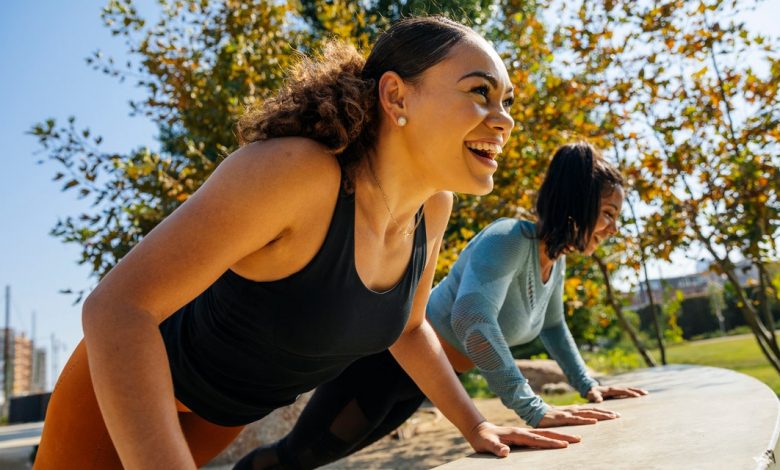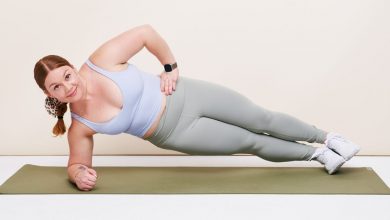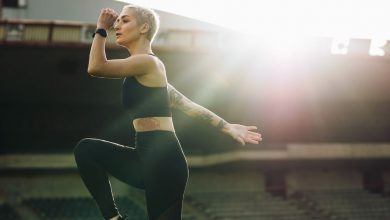3 Push-Up Modifications to Try If You Can’t Yet Get a Full One

Sure, the push-up is a bodyweight exercise, but that doesn’t mean it’s easy—in fact, it can be really challenging to master. That’s why push-up modifications (basically, less intense versions of the OG exercise) are so useful. These variations ease up the challenge by reducing the amount of load you have to push with each rep while allowing you to practice the movement pattern and build the strength you need to crush a full one. And just like the traditional from-the-floor push-up, you don’t need any equipment, making them an easy addition to your routine.
Below, we have three great push-up mods to try along with expert intel on the muscles these moves work, why they’re great regressions (i.e., more beginner-friendly variations on the traditional exercise), and exactly how to use them to build up to the full thing. Stay right here for all the must-know info!
What’s the best way to modify push-ups?
There are two main ways to modify push-ups: Stay on the floor but drop to your knees. Or stay on your toes but elevate your hands on a stable surface, like a box, step, table, or even wall. In either scenario, you’re reducing the total load that your upper body has to control through the range of motion, Susie Reiner, PhD, CSCS, a postdoctoral researcher at the University of Kentucky and certified exercise physiologist, tells SELF. That makes it easier to bang out your reps than a from-the-floor pushup where you’re in a high plank position.
But there are some differences between the two. With knee push-ups, your hands are on the ground, which helps you get familiar with the angle of pushing up against the floor, Dr. Reiner says. This positioning also places your chest almost directly over your hands, which requires a fair amount of wrist extension and can cause discomfort in some people who have limited mobility in that joint, Dr. Reiner says. So this variation may not feel as great for people with those issues. (If that’s the case for you, case Dr. Reiner suggests making it more comfy by placing towels under the palms, doing the move while gripping dumbbells, or adding wrist mobility exercises to your routine.)
Elevated push-ups have your hands, well, elevated while your toes stay on the ground. This allows you to feel the sensation of a full push-up without having to lift as much of your body weight, Dr. Reiner says. “It’s similar to using an assisted pull-up machine that counteracts some of your body weight,” she explains. Basically, you’re practicing the full-on movement pattern but with less resistance, which allows you to nail great form without overloading your muscles. This mod also puts you in a high plank, which engages all parts of your body that are fired up in that position, including your upper body plus your core, quads, and glutes. These muscles aren’t challenged as much in the elevated stance compared to an on-the-ground plank, but you are helping yourself get acclimated to this position, Dr. Reiner says, which will come in clutch down the line for doing a full push-up. To boot, elevated push-ups put your body at a slightly different angle that’s not as intense on the wrists compared to their on-the-floor counterparts, Dr. Reiner adds.
So which push-up modification is best? There’s no definitive ranking. What’s most important is finding a variation (or several!) that works to “challenge you but not overwhelm you,” Janet Hamilton, CSCS, founder of Running Strong in Georgia, tells SELF, tells SELF.
That way, you’ll encourage your muscles to grow bigger and stronger while minimizing injury risk. Keep in mind the right mods for you can (and should) change with time as your pushing abilities improve. For example, maybe you start with a wall push-up (the easiest variation of the hands-elevated mod, since you’re bearing a lot of your weight through your feet), then move to a knee push-up (which should feel more challenging), then progress to a low box elevated push-up (which, if you use a low enough box, should be even more intense). The most important thing is to focus on good form and level up the intensity of the move once it starts to feel easy.
What muscles do push-up modifications work?
With a modified push-up—whether you’re on your knees or elevating your hands—you’re essentially doing the same movement pattern as a traditional one, Dr. Reiner says. That means you’re engaging all the same muscles too.
This includes the ones in your chest (pectoralis major and minor), front part of your shoulders (anterior deltoids), and backs of your arms (triceps), Dr. Reiner says. Muscles in your hands and forearms are also working to stabilize your arms, Hamilton adds. And your core fires up too, since that’s what stabilizes your body and keeps it in that straight line as you crank out reps, Dr. Reiner adds.
The difference? The traditional push-up delivers more of a challenge to all these muscles, since you’re moving more load. Case-in-point: A small 2011 study involving 28 men, published in the Journal of Strength and Conditioning Research, found that in a traditional push-up, people supported 69% of their bodyweight in the up position and 75% in the down position. In a knee push-up, that load dropped to 54% of bodyweight in the up position and 62% in the down position. With a hands elevated push-up, the amount of load varies based on how high you place your palms. The higher they go, the less bodyweight your upper body has to move, since more weight is being supported through your feet, Hamilton explains.
Long story short, push-up modifications engage all the same muscles as the traditional version, just to a lesser degree. And doing mods—especially ones that feel challenging yet doable for you—is smart if your goal is to one day crush a full push-up. That’s because they are effective for building the specific upper-body strength you need.
But that’s not their only benefit. Push-up modifications can help you more easily and safely crush everyday life tasks that rely on a strong upper body, say, like carrying groceries, hauling small children, pushing a lawn mower, stacking dishes onto a high shelf, and toting a sack of dog food, Hamilton says. Plus, they can improve your ability to get up and down from the ground, Dr. Reiner says, since they allow you to comfortably put more weight into your hands to help you.
How can you use push-up modifications to do a full push-up?
Push-up modifications can absolutely help you crush the full thing, but the process isn’t overnight—it takes time and consistency. Dr. Reiner likens it to doing a marathon: You wouldn’t lace up for the first time and then attempt 26.2 miles the next day. “The same goes for mastering a push-up,” she says.
Elevated push-ups are a great place to start, Dr. Reiner says. Remember: The higher the surface, the easier the move will be. As you do them, make sure you focus on full range of motion and keep your body in one long, straight line with your core engaged, she says. Knee push-ups can also be a good starting point depending on your current strength level. If you have wrist issues, try making some of the tweaks suggested above (like placing a towel under your palms or gripping dumbbells) to see what’s most comfy for you. Here’s a step-by-step progression that explains which push-up modifications to do when.
Alongside mods, you can incorporate other resistance training exercises that strengthen the same muscles—think chest presses, chest flies, and triceps extensions, Dr. Reiner says. She also suggests doing core work like planks on your hands or elbows to train your body to maintain proper push-up positioning.
3 push-up modifications to try
Ready to start your push-up journey? Here are three modifications that can build serious upper-body strength and get you closer to the real deal.
1. Chair Push-Up
Katie Thompson
- Place your hands shoulder-width apart on a chair (or other sturdy elevated surface) and assume a high plank position with your feet, knees, hips, and shoulders in a straight line. Brace your core and keep your elbows tucked in close to the sides of your torso. This is the starting position.
- Bend your elbows and pull shoulder blades together to lower your chest to the chair.
- Press through your palms to straighten your arms back to starting position. This is 1 rep.
In this modification, you’re elevating your hands on a relatively high surface to reduce the amount of load that your upper-body has to push. The taller the surface, the less challenging the exercise will feel. For a really beginner-friendly option, use a wall as your elevated surface: Stand a few feet away from it and place your hands shoulder-width apart in front of you. Bend and straighten your arms to complete a push-up.
2. Low-Box Push-Up
Katie Thompson
- Place your hands shoulder-width apart on a low box (or other sturdy surface that’s close to the ground) and assume a high plank position with your feet, knees, hips, and shoulders in a straight line. Brace your core and keep your elbows tucked in close to the sides of your torso. This is the starting position.
- Bend your elbows and pull shoulder blades together to lower your chest to the box.
- Press through your palms to straighten your arms back to starting position. This is 1 rep.
This mod is really similar to the chair push-up, except you’re placing your hands on a lower surface. That makes the move more challenging, since there’s more load you have to push with your upper body.
3. Knee Push-Up
Katie Thompson
- Start in a high plank with hands slightly wider than shoulder-width apart, shoulders above your wrists, and your spine long.
- Drop to your knees, rolling to the top of your knees to protect your knee caps.
- Bend your elbows and lower your chest to the ground.
- Push through the palms of your hands to straighten your arms. That’s 1 rep.
The knee push-up can feel more or less challenging than the low box mod. It all depends on the height of the box. Regardless, this variation is easier than the OG push-up since dropping to your knees reduces the total weight you have to push by eliminating your lower legs from the picture.
Demoing the moves above are Alex Orr (GIF 1), a non-diet NASM-certified personal trainer and CNC; Laura Girard (GIF 2), a NASM-certified personal trainer and founder of The Energy Academy; and Alicia Jamison (GIF 3), senior coach at Body Space Fitness and adjunct lecturer at Brooklyn College.
Related:



